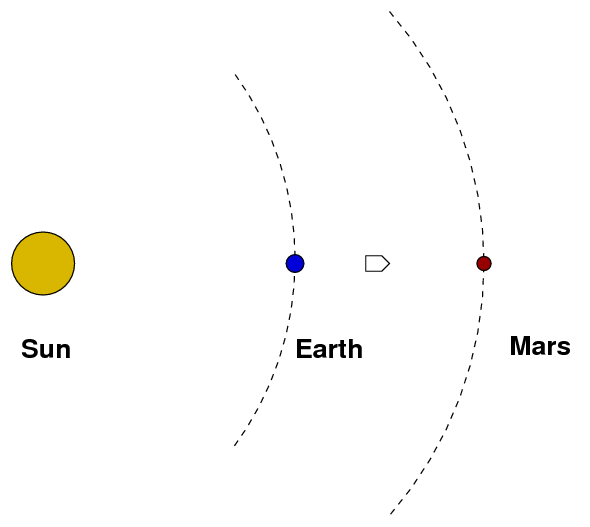
 Copyright © Michael Richmond.
This work is licensed under a Creative Commons License.
Copyright © Michael Richmond.
This work is licensed under a Creative Commons License.
Suppose that we have built a spaceship and placed it into orbit far above the Earth -- far enough that the gravitational influence of the Earth is small. The plan is to drive the ship out to the orbit of Mars.

Now, in real life, rocket scientists have to take into account a HOST of effects, such as angular momentum, orbital velocity, the rocket effect, and many others. We are going to ignore all that for now (though we will start to learn about some of those other factors soon enough), and pay attention to just one little bit of the problem: the difference in Gravitational Potential Energy (GPE) between the orbits of the Earth and Mars.
Let's use the following values:
mass of Sun M = 1.99 x 1030 kg mass of ship m = 1 kg radius of Earth's orbit Re = 1.50 x 1011 m radius of Mars's orbit Rm = 2.28 x 1011 m
Can you calculate the following quantities? (Hint: they are exactly the same size)
Now, suppose that we give the ship engines which burn a refined version of kerosene (RP1) and oxygen. The energy released when these two chemicals combine is
energy released E = 12 x 106 Joules per kg
(This represents the energy released when the optimal ratio of kerosene to oxygen is mixed together: about 2.5 kg of oxygen for every 1 kg of kerosene).
Remember, this is a very simplified view of the situation. As we will see soon, analyzing real rockets requires a careful treatment of the momentum of the rocket and its exhaust.
 Copyright © Michael Richmond.
This work is licensed under a Creative Commons License.
Copyright © Michael Richmond.
This work is licensed under a Creative Commons License.